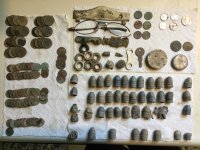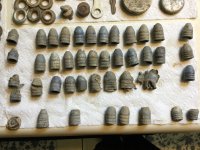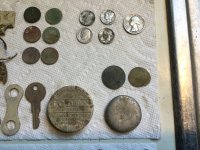Geologyhound
Well-known member
These are finds from two days of hunting at the same site. I had never found a Civil War bullet and always wanted to. I thought perhaps I might someday find one or two, but I never imagined I would find this many. With all the iron grunts, I was using the Tekkna program with the 11x13 on my Deus 2. These all were a little twitchy on the VDI #, but were between 78-82. One which was mashed read 84. They all gave a nice tone. If I got a faint or iffy signal, I checked it with my custom fast program. If that gave me a better tone and/or a more consistent reading in the right range, I dug.
There appear to be at least four or five styles, perhaps more. The main group all are about the same length with a domed top and a flat spot on the tip. All of the flanges are roughly equal in size. There is also a group of three on the right which are shorter and have much smaller flanges. There is a group of four two-ringers on the left - all of which are shorter than the main group and have a shorter tip. Two of these have a wider bottom flange and two have a shorter bottom flange. In the bottom row, one bullet has a wider bottom flange and a more conical top than the main group. Most of the rest in the bottom row appear to be slightly shorter and have a bigger flat spot on the tip. Perhaps this is from hitting something, but they are not mushroomed out. I don’t know how much of this variation might be due to different bullet molds. From what I have heard, if they don’t have a dimple in the bottom, the bullets are “newer“. The two in the lower right corner don’t have a dimple. There is also a completely mushroomed bullet on the lower left. But, it appears to have a copper sheath base with a central post, and as such is probably much newer. Any help on identifying the rifle types would be greatly appreciated!
I found plenty of clad and five silvers. One of the Mercury dimes is 1916. I was afraid to look for the mint mark. Unfortunately it is Philadelphia. There are six wheats, three of which are from the 19 teens. I haven’t tried cleaning the full date area yet on those until they can dry out a bit more.
The Iodex mentholated ointment sample tin is theoretically from the 1920s. One of the blank discs is actually an old wheat penny which appears to have been mashed on a railroad. The other one is copper or brass, 25 mm, and looks like it had a raised rim. However, I can’t make out any detail on either side other than what appears to be spokes around the rim like an IHP (which would be 19 mm).
I do not know what the other grey disc is next to the Iodex tin. It is heavy, thicker than a coin, has no details on either side, is completely non-magnetic, looks more silver than lead, but not enough silver to be silver.
Thanks for any help, and thanks for looking!
There appear to be at least four or five styles, perhaps more. The main group all are about the same length with a domed top and a flat spot on the tip. All of the flanges are roughly equal in size. There is also a group of three on the right which are shorter and have much smaller flanges. There is a group of four two-ringers on the left - all of which are shorter than the main group and have a shorter tip. Two of these have a wider bottom flange and two have a shorter bottom flange. In the bottom row, one bullet has a wider bottom flange and a more conical top than the main group. Most of the rest in the bottom row appear to be slightly shorter and have a bigger flat spot on the tip. Perhaps this is from hitting something, but they are not mushroomed out. I don’t know how much of this variation might be due to different bullet molds. From what I have heard, if they don’t have a dimple in the bottom, the bullets are “newer“. The two in the lower right corner don’t have a dimple. There is also a completely mushroomed bullet on the lower left. But, it appears to have a copper sheath base with a central post, and as such is probably much newer. Any help on identifying the rifle types would be greatly appreciated!
I found plenty of clad and five silvers. One of the Mercury dimes is 1916. I was afraid to look for the mint mark. Unfortunately it is Philadelphia. There are six wheats, three of which are from the 19 teens. I haven’t tried cleaning the full date area yet on those until they can dry out a bit more.
The Iodex mentholated ointment sample tin is theoretically from the 1920s. One of the blank discs is actually an old wheat penny which appears to have been mashed on a railroad. The other one is copper or brass, 25 mm, and looks like it had a raised rim. However, I can’t make out any detail on either side other than what appears to be spokes around the rim like an IHP (which would be 19 mm).
I do not know what the other grey disc is next to the Iodex tin. It is heavy, thicker than a coin, has no details on either side, is completely non-magnetic, looks more silver than lead, but not enough silver to be silver.
Thanks for any help, and thanks for looking!







